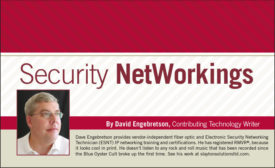Integration & Network Solutions
The Limitless Possibilities Of IP-Based Entry Control & Emergency Stations
Networked-based entry control and emergency station products are opening up wide opportunities for security dealers and integrators in both new and retrofit markets.
August 22, 2018
The Case for HD Over Coax
Familiarity and ease of deployment make HDoC a compelling alternative for new installations.
July 16, 2018
SDM 2018 Top Systems Integrators Report: A Security Transformation Is Underway
In the security systems integration industry, while factors such as a great economy and stimulation of buyers by continued security threats are contributing to growth, it’s the morphing of security technology into broader business applications that is starting to drive noticeable demand.
July 10, 2018
The Power of Deploying Video Analytics in the Cloud
As technology migrates to the cloud, so do analytics, offering more benefits than you might think.
July 9, 2018
Be in the forefront of security intelligence when you receive SDM.
Join over 10,000+ professionals when you subscribe today.
SIGN UP TODAY!Copyright ©2025. All Rights Reserved BNP Media.
Design, CMS, Hosting & Web Development :: ePublishing













